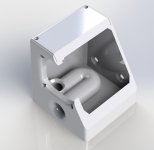The mention of 3D printing brings up the point that in a really small speaker the box material takes up a lot of the gross volume. Stiffer, thinner walls 3D printed (or say sheet Al) can make for significantly more available net volume.
dave
dave
I was going to recommend something with the sb65wbac25-4 too. They are perfect for this kind of application.
Dave, I just posted about a bass reflex I'd just finished using a slightly risky 5mm thick wall. Between the two perimeters is a gyroid infill, essentially a box on springs within a box, since there's no direct linear connections between the two in any axis. There is some audible HF coming through but you have to press your ear to the enclosure to hear it and, even 10mm away, the HF from the driver takes over.
When I printed my micro TQWT, I also made the pictured tiny bass reflex, to compare the performance of TQWT against a BR using the same TEBM36S12 drivers. As expected, it went a bit deeper and had more power at the expense of the usual monotonal bass port thud.
When I printed my micro TQWT, I also made the pictured tiny bass reflex, to compare the performance of TQWT against a BR using the same TEBM36S12 drivers. As expected, it went a bit deeper and had more power at the expense of the usual monotonal bass port thud.
Attachments
I agree, that the performance to dollars ratio doesn't work out really well for speakers this size
you can actually get VERY good performance out of small fullranges, except for bass depth and SPL. Don,t worry 😉
Chances are the other components will be the weakest links...
I put a 5F/8422T-01 in a 1 liter sealed box and was not expecting it to sound as good as it did. A pair of those ran the price way over the pre-made options and are likely overkill for the source and amp but it is a fun build and I think he will enjoy them.
They’re delightful little drivers. I’m very glad that you tried them. Sometimes I feel like a cheerleader in an empty stadium. (No irony intended.) I’m under the impression that they’re better utilized by our counterparts in Japan. I’ve seriously considered developing a niche commercial product based on them.
I saw somewhere a recommendation to put a 330 uf capacitor in series with them as a high pass filter to prevent them from trying to reproduce too low of frequencies. Is that a good idea?
in theory it's a good idea, also it protects from amp or source failure.
I'd certainly do it if good caps were cheaper...
I'd certainly do it if good caps were cheaper...
I have used second-order line-level crossovers at 100Hz & 120Hz with them. I think 100Hz is adequate as long as the level is reasonable. A fourth-order would be interesting.
The design of these was really kind of a thought experiment joined with a little trial and error, but at moderate sound levels I am absolutely astonished how good they sound, and that includes going down to some surprisingly low notes for their size.
Built a pair for my son, have the parts to make a pair for myself.
'small wonder' fullrange mini monitor (beginner's luck)
Built a pair for my son, have the parts to make a pair for myself.
'small wonder' fullrange mini monitor (beginner's luck)
Those look great. It is cool to be able to look at everyday things and picture them in uses like that
- Home
- Loudspeakers
- Full Range
- really small computer speakers
